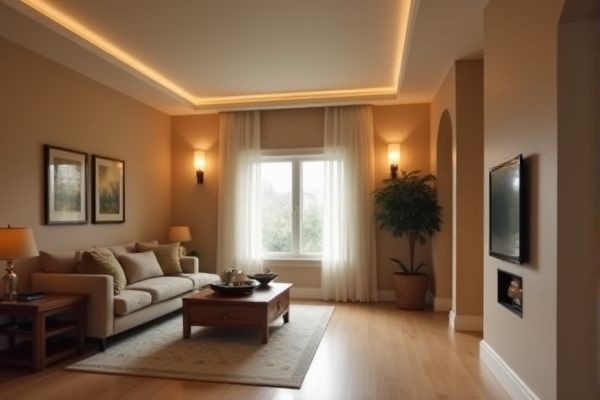
Sconce lighting adds decorative flair and ambient illumination by projecting light outward from the wall, making it perfect for accentuating room features or creating cozy atmospheres. Your choice between sconce and recessed lighting depends on whether you want a visible design element or a subtle, built-in light source--explore the article to learn which suits your space best.
Table of Comparison
| Feature | Sconce Lighting | Recessed Lighting |
|---|---|---|
| Installation Location | Mounted on walls | Installed inside ceiling or walls |
| Light Direction | Upward, downward, or adjustable | Downward-focused or adjustable trims |
| Space Usage | Projects outward, occupies wall space | Flush with surface, saves space |
| Aesthetic Impact | Decorative, adds style | Minimalist, sleek look |
| Typical Uses | Accent lighting, ambiance, hallways | General lighting, task lighting, kitchens |
| Installation Complexity | Moderate, requires wall wiring | Higher, involves ceiling modifications |
| Cost Range | Lower to moderate | Moderate to high |
| Maintenance | Easy access for bulb replacement | Requires ceiling access, more complex |
Introduction to Sconce and Recessed Lighting
Sconce and recessed lighting serve distinct purposes in interior design, with sconces mounted on walls to provide ambient or accent lighting, while recessed lighting is installed into ceilings for a sleek, unobtrusive look. Sconces often add decorative flair and create focal points, ideal for highlighting artwork or architectural features. Recessed lighting offers even illumination across a room without drawing attention to the fixture, making it perfect for general lighting needs.
Defining Sconce Lighting
Sconce lighting refers to wall-mounted fixtures that provide ambient or accent illumination by directing light either upwards, downwards, or both, enhancing the aesthetic and functional aspects of a space. These fixtures are available in various styles, materials, and sizes, often serving as decorative elements while offering localized lighting for hallways, living rooms, or bedrooms. Unlike recessed lighting, which is embedded into ceilings for a streamlined look, sconce lighting stands out as an integral design feature on walls.
Understanding Recessed Lighting
Recessed lighting features fixtures installed within the ceiling, creating a streamlined, unobtrusive illumination ideal for modern interiors. These lights provide focused or ambient lighting while maintaining a clean ceiling line, making them perfect for minimalistic design aesthetics. Unlike sconces, recessed lighting effectively maximizes ceiling space and reduces visual clutter.
Key Differences Between Sconce and Recessed Lighting
Sconce lighting is surface-mounted on walls, providing ambient or accent light with decorative fixture designs that enhance room aesthetics, while recessed lighting is installed flush within the ceiling, offering a sleek, unobtrusive source of general or task illumination. Sconces often create localized pools of light and contribute to room ambiance or style, whereas recessed lights distribute light evenly across larger areas, minimizing shadows. Installation complexity varies, with sconces requiring wall wiring and mounting, and recessed lights needing ceiling access and housing, influencing their suitability for different architectural spaces.
Aesthetic Impact: Sconce vs Recessed Lighting
Sconces create a decorative focal point by casting light upward or downward, enhancing wall texture and adding visual interest to your space. Recessed lighting offers a sleek, minimalist aesthetic that provides subtle, evenly distributed illumination without interrupting architectural lines. Your choice depends on whether you want lighting to be a design feature or to blend seamlessly for a modern, uncluttered look.
Installation Requirements and Considerations
Sconce lighting typically requires surface mounting on walls, making installation straightforward with access to existing wiring, while recessed lighting demands cutting precise holes in ceilings and sufficient ceiling depth to house fixtures and wiring. Recessed lights often require professional installation due to the complexity of electrical work and ensuring insulation contact (IC) ratings for safety and energy efficiency. Your choice should consider ceiling structure, wiring accessibility, and desired aesthetic for optimal installation outcomes.
Best Applications for Sconce Lighting
Sconce lighting is ideal for creating ambient or accent lighting in hallways, living rooms, and bedrooms where wall space allows for decorative fixtures. It enhances architectural features and provides task lighting near mirrors or seating areas without requiring ceiling installation. Best suited for adding warmth and style, sconces complement traditional, rustic, and transitional interior designs.
Ideal Uses for Recessed Lighting
Recessed lighting is ideal for creating a clean, minimalist look while providing even, unobtrusive illumination in kitchens, hallways, and living rooms. It works well in low-ceiling spaces or areas where you want to avoid bulky fixtures, offering flexibility in lighting zones and accentuating architectural features. You can strategically position recessed lights to enhance task lighting or highlight artwork without overwhelming the room's aesthetic.
Energy Efficiency and Maintenance Comparison
Sconces generally consume more energy because they use exposed bulbs and often require higher wattage to illuminate a space effectively, while recessed lighting typically utilizes LED bulbs that offer superior energy efficiency. Maintenance for sconces involves regular dusting and occasional bulb replacement, which can be less convenient compared to recessed lighting, where bulbs are enclosed and last longer, reducing the frequency of upkeep. Your choice between these lighting options should consider both energy consumption and ease of maintenance to optimize long-term performance and costs.
Choosing the Right Lighting Solution for Your Space
Sconces provide decorative, ambient lighting ideal for accentuating walls and adding warmth to your space, while recessed lighting offers a streamlined, unobtrusive option that delivers even, task-focused illumination. Your choice depends on the room's function, ceiling height, and desired lighting effect--sconces suit cozy, intimate areas, whereas recessed fixtures are perfect for modern, minimalist designs requiring widespread light. Consider factors like ceiling structure and wiring accessibility to ensure the selected lighting complements both your aesthetic and practical needs.
 homyna.com
homyna.com